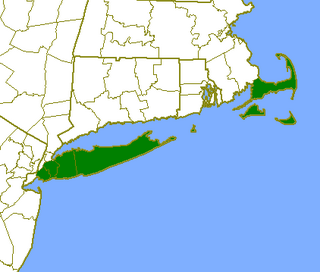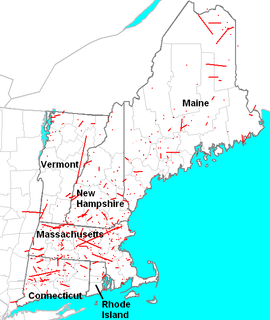 W
WThe Atlantic Northeast is a region of North America which includes the U.S. states of Connecticut, Massachusetts, Rhode Island, New Hampshire, Vermont, and Maine, and the Canadian provinces of Québec, Nova Scotia, New Brunswick, Prince Edward Island and Newfoundland and Labrador.
 W
WThe Connecticut River is the longest river in the New England region of the United States, flowing roughly southward for 406 miles (653 km) through four states. It rises at the U.S. border with Quebec, Canada, and discharges at Long Island Sound. Its watershed encompasses 11,260 square miles (29,200 km2), covering parts of five U.S. states and one Canadian province, via 148 tributaries, 38 of which are major rivers. It produces 70% of Long Island Sound's fresh water, discharging at 18,400 cubic feet (520 m3) per second.
 W
WThe Fort River is a river in Western Massachusetts and is a tributary of the Connecticut River and runs through the towns of, Amherst, Massachusetts, and ends in Hadley, Massachusetts.
 W
WNew England is a region in the North Eastern United States consisting of the states Rhode Island, Connecticut, Massachusetts, New Hampshire, Vermont, and Maine. Most of New England consists geologically of volcanic island arcs that accreted onto the eastern edge of the Laurentian Craton in prehistoric times. Much of the bedrock found in New England is heavily metamorphosed due to the numerous mountain building events that occurred in the region. These events culminated in the formation of Pangaea; the coastline as it exists today was created by rifting during the Jurassic and Cretaceous periods. The most recent rock layers are glacial conglomerates.
 W
WGreater Boston is the metropolitan region of New England encompassing the municipality of Boston, the capital of the U.S. state of Massachusetts and the most populous city in New England, as well as its surrounding areas. The region forms the northern arc of the US northeast megalopolis and as such, Greater Boston can be described either as a metropolitan statistical area (MSA), or as a broader combined statistical area (CSA). The MSA consists of most of the eastern third of Massachusetts, excluding the South Coast region and Cape Cod; while the CSA additionally includes the municipalities of Providence, Rhode Island, Manchester, Worcester, Massachusetts, as well as the South Coast region and Cape Cod in Massachusetts. While the small footprint of the city of Boston itself only contains an estimated 685,094, the urbanization has extended well into surrounding areas; the CSA is one of two in Massachusetts, the only other being Greater Springfield. Greater Boston is the only CSA-form statistical area in New England which crosses into three states.
 W
WLong Island Sound is a tidal estuary of the Atlantic Ocean, lying predominantly between the U.S. state of Connecticut to the north, and Long Island in New York to the south. From west to east, the sound stretches 110 mi (180 km) from the East River in New York City, along the North Shore of Long Island, to Block Island Sound. A mix of freshwater from tributaries and saltwater from the ocean, Long Island Sound is 21 mi (34 km) at its widest point and varies in depth from 65 to 230 feet.
 W
WThe Merrimack Valley is a bi-state region along the Merrimack River in the U.S. states of New Hampshire and Massachusetts. The Merrimack is one of the larger waterways in the New England region and has helped define the livelihood and culture of those living along it since native times.
 W
WThe Outer Lands is the prominent terminal moraine archipelagic region off the southern coast of New England in the United States. This eight-county region of Massachusetts, Rhode Island, and New York, comprises the peninsula of Cape Cod and the islands of Martha's Vineyard, the Elizabeth Islands, Nantucket, Block Island, the Narragansett Bay Islands, Staten Island, and Long Island, as well as surrounding islands and islets.
 W
WTornadoes are fairly uncommon in the US region of New England. Fewer tornadoes are recorded here than anywhere else east of the Rocky Mountains. However, these deadly and destructive storms do occur; on average, about eight tornadoes are reported in the region each year. Almost 200 people have been killed by these storms in recorded history, and two of the ten most destructive tornadoes in US history occurred in this region.
 W
WThe White Mountains are a mountain range covering about a quarter of the state of New Hampshire and a small portion of western Maine in the United States. They are part of the northern Appalachian Mountains and the most rugged mountains in New England. The range is heavily visited due to its proximity to Boston and, to a lesser extent, New York City and Montreal, Quebec, Canada.